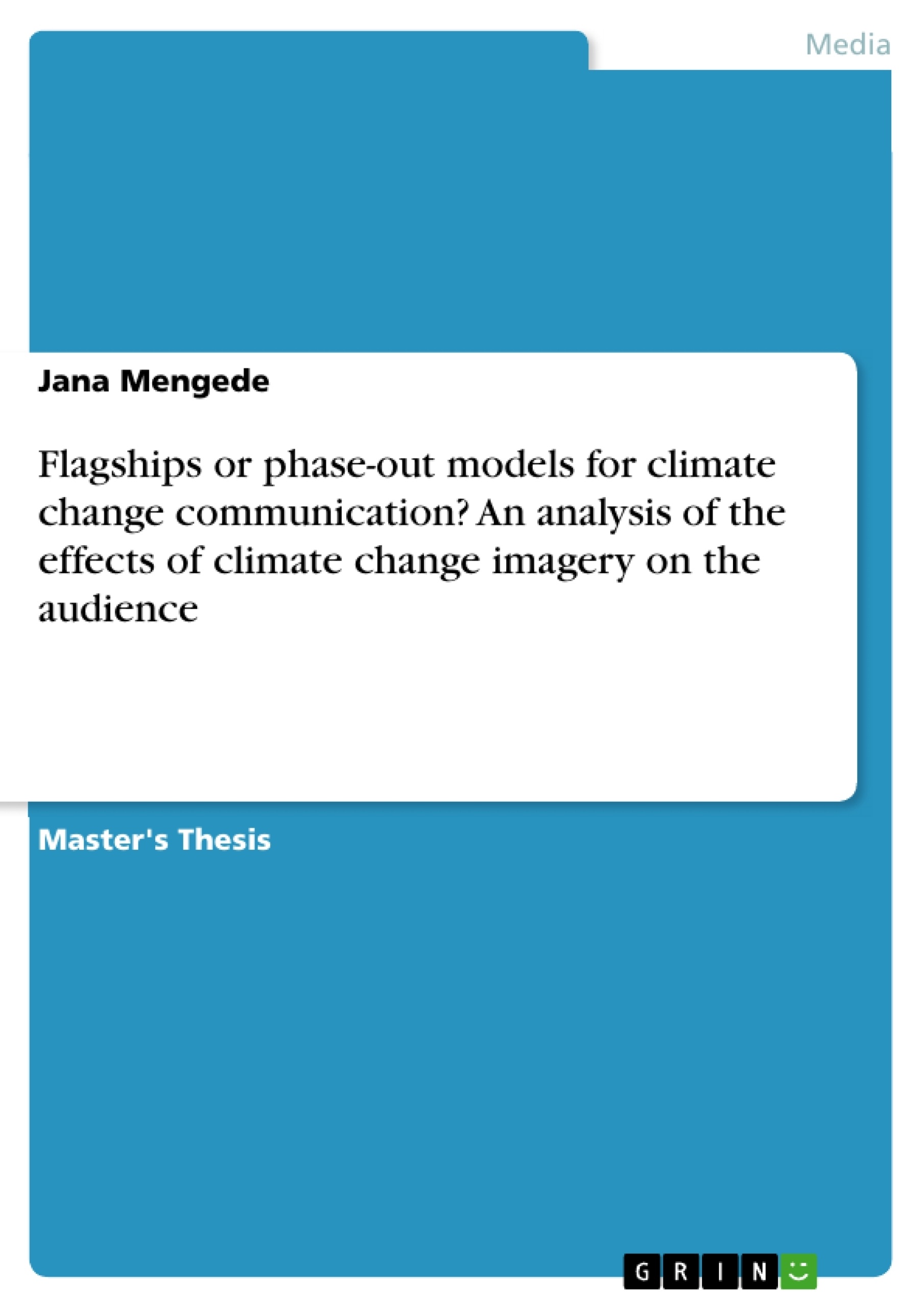
Flagships or phase-out models for climate change communication? An analysis of the effects of climate change imagery on the audience
Masterarbeit, 2021
122 Seiten, Note: 1,2
Leseprobe
Table of Contents
- Introduction
- Media Coverage Trends in the 2000s
- Stakeholders in Climate Change Communication
- Challenges of Science Journalism
- Psychological Effects of Communication
- Science Literacy
- Summary and Comment
- Theoretical Part
- Climate Change Communication
- Media Coverage Trends in the 2000s
- Stakeholders in Climate Change Communication
- Challenges of Science Journalism
- Psychological Effects of Communication
- Science Literacy
- Summary and Comment
- Visual Climate Change Communication
- Visual Science Communication
- Definition: The Use of the Term Image
- Climate Change Imagery
- People
- Causes
- Impacts
- Extreme weather
- Floods
- Drought and Heat
- Ice Imagery
- The Role of Animal Imagery
- Solutions
- Summary and Hypothesis
- Method
- Excursus: Scientific Analysis Methods
- Quantitative Analysis of Image Types
- Visual Communication Process Model
- Conception of the Research Plan
- Sample Selection – Research Criteria
- Explorative Research of Image Effects via Online Survey
- Definition of the Target Group
- Results
- Quantitative Analysis of Image Types
- Results Germany
- Results UK
- Results US
- Results Instagram
- Summary and Discussion
- Explorative Research of Image Effects – Evaluation of the Survey Results
- Basic Statistics
- Previous Knowledge of the Participants
- Excursus: Scale Definition
- The Effects of People Imagery on the Participants
- The Effects of Causes Imagery on the Participants
- The Effects of Impacts Imagery on the Participants
- The Effects of Solutions Imagery on the Participants
- Discussion
- The Flagships of Visual Climate Change Communication
- Assessment on the Salience of the Flagships
- Assessment on the Self-Efficacy-Level of Climate Change Solution Imagery
- Conclusion
Objectives and Key Themes
This Master Thesis investigates the use of climate change imagery in the media and its effects on audiences. The main goal is to determine which visual motives are commonly used, whether these motives still promote salience among audiences, and whether imagery of climate change solutions evokes positive feelings and can therefore be considered motivating.
- The role of visual communication in raising awareness about climate change
- The impact of repeated imagery on audience engagement and perception
- The effectiveness of visual representations of climate change solutions in promoting self-efficacy
- The influence of previous knowledge and personal experiences on image interpretation and emotions
- The potential of social media platforms as a means of disseminating climate change solution imagery
Chapter Summaries
The theoretical part of the thesis examines the history and current trends in climate change communication. It delves into the challenges of science journalism, analyzes the psychological effects of communication, and explores the concept of science literacy. The chapter on visual climate change communication defines the term "image" and introduces four visual domains: people, causes, impacts, and solutions. It then examines the imagery associated with each domain and their respective effects on audiences.
The methodical part describes the research plan, including the selection criteria for the image sample and the methodology used for the online survey. The Visual Communication Process Model (VCPM) serves as a theoretical framework for analyzing the effects of imagery.
The results chapter presents the findings from both the quantitative analysis of image types and the explorative research of image effects. The quantitative analysis focuses on identifying the leading motives used by the media. The survey results then evaluate the perceived meaning, interpretation, and emotional reactions of participants to different climate change imageries.
The discussion section analyzes the findings in relation to the hypotheses of the thesis. It identifies key trends in the use of climate change imagery, evaluates the effectiveness of specific flagship images, and examines the potential of social media for disseminating climate change solution imagery.
Keywords
Climate change communication, Climate change imagery, Image effects, Visual communication, Visual communication process model, Salience, Self-efficacy, Flagship species, Social media, Media coverage.
Details
- Titel
- Flagships or phase-out models for climate change communication? An analysis of the effects of climate change imagery on the audience
- Hochschule
- SRH Fernhochschule
- Note
- 1,2
- Autor
- Jana Mengede (Autor:in)
- Erscheinungsjahr
- 2021
- Seiten
- 122
- Katalognummer
- V1156909
- ISBN (Buch)
- 9783346561596
- Sprache
- Englisch
- Anmerkungen
- Weitere Quellenangaben und Nachweise, die nicht im PDF enthalten sind, können bei Bedarf vollumfänglich zur Verfügung gestellt werden (z.B. Fragebogen, Excel-Dateien etc.).
- Schlagworte
- Climate Change Climate Change Communication Climate Change Imagery Visual Communication Image Effects
- Produktsicherheit
- GRIN Publishing GmbH
- Preis (Ebook)
- US$ 42,99
- Preis (Book)
- US$ 54,99
- Arbeit zitieren
- Jana Mengede (Autor:in), 2021, Flagships or phase-out models for climate change communication? An analysis of the effects of climate change imagery on the audience, München, Page::Imprint:: GRINVerlagOHG, https://www.diplomarbeiten24.de/document/1156909
- Autor werden
- Ihre Optionen
- Vertriebskanäle
- Premium Services
- Autorenprofil
- Textarten und Formate
- Services für Verlage, Hochschulen, Unternehmen

- © GRIN Publishing GmbH.
- Alle Inhalte urheberrechtlich geschützt. Kopieren und verbreiten untersagt.
- info@grin.com
- AGB
- Open Publishing
Der GRIN Verlag hat sich seit 1998 auf die Veröffentlichung akademischer eBooks und Bücher spezialisiert. Der GRIN Verlag steht damit als erstes Unternehmen für User Generated Quality Content. Die Verlagsseiten GRIN.com, Hausarbeiten.de und Diplomarbeiten24 bieten für Hochschullehrer, Absolventen und Studenten die ideale Plattform, wissenschaftliche Texte wie Hausarbeiten, Referate, Bachelorarbeiten, Masterarbeiten, Diplomarbeiten, Dissertationen und wissenschaftliche Aufsätze einem breiten Publikum zu präsentieren.
Kostenfreie Veröffentlichung: Hausarbeit, Bachelorarbeit, Diplomarbeit, Dissertation, Masterarbeit, Interpretation oder Referat jetzt veröffentlichen!
- GRIN Verlag GmbH
-
- Nymphenburger Str. 86
- 80636
- Munich, Deutschland
- +49 89-550559-0
- +49 89-550559-10
- info@grin.com
-









